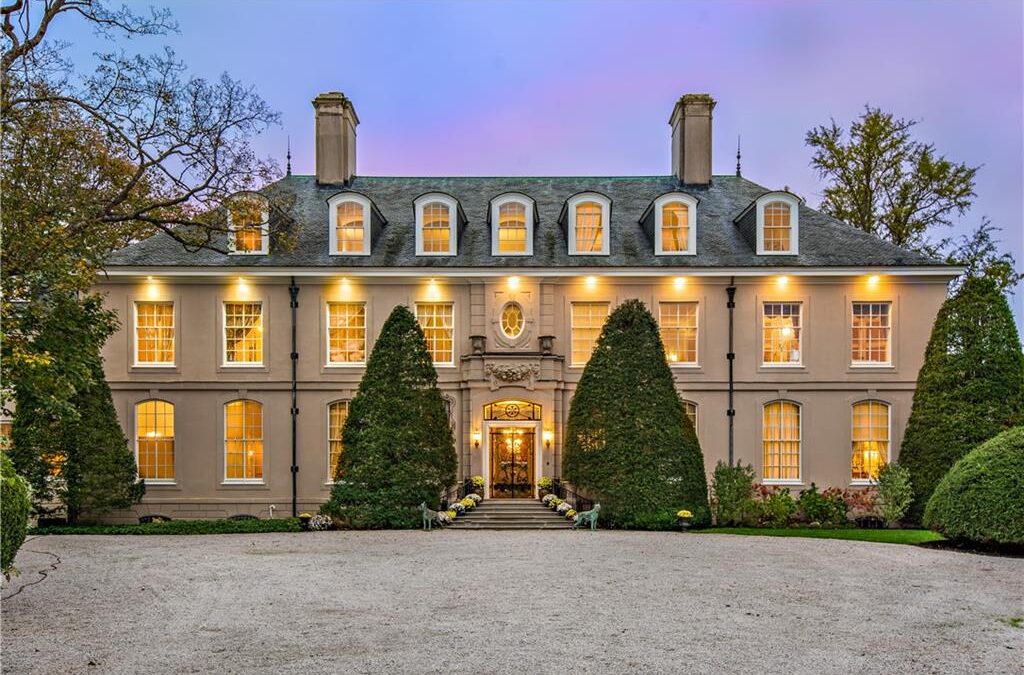If there is one thing that the great houses of Newport were really built for, it is to throw a party. Sometimes it seems like the great “cottages” are really just ballrooms with (comparatively) small five and six-bedroom houses attached. Belcourt Castle (until the intervention of Alva Smith Vanderbilt Belmont) was really just a gigantic one-bedroom apartment built over a set of stables. Marble House is famous for its single, grand guest bedroom and Rosecliff’s great interior ballroom dominates the house where Tessie Oelrichs once entertained so lavishly during the six or eight weeks a year that her family lived in Newport. These three houses and Beechwood, Marble House’s next-door neighbor, continue to serve as the sites for fabulous weddings and special events many weekend evenings during the summer. But it is not just these more public venues that are used to host great parties – private residences such as Bois Dore are also known to turn heads.
This past weekend, Bois Doré, the great French Provincial style home of Dr. and Mrs. David Keefe on Narragansett Avenue, played host to a white-tie dinner and dance to help raise attention and financial support for research into the most understudied and difficult-to-treat cancers. This wonderful building was among the last great houses (and ballrooms) built in Newport, having been designed by New York architect Charles Platt in 1928. Designed in a style that is far sparer and less fussy than many of the mansions of the Gilded Age, it has a clean limestone façade with the only elaboration coming at the entrance door on axis with the main driveway entering the estate. The layout of the building is long and linear with the kitchen and functional areas on the east side connected by a grand hall to the large ballroom on the west side of the building. The living and dining areas are arranged en feuillard parallel to this axis so that long views are possible over a distance of more than 150 feet within the house itself! While the house is large, this technique of aligning rooms like beads on parallel strings gives the house a magnified sense of spaciousness that is far greater than one expects looking at the exterior façade.
The Hope Funds dinner was set-up to accommodate the sell-out group of 125 dinner attendees at three long tables in the ballroom. This “state dinner” like setting was typical of most formal events until Newporter Jacqueline Bouvier Kennedy turned entertaining on its head by seating guests at round tables during the Kennedy years in the White House. Modeled on the Nobel Award dinners held in Stockholm, Sweden, long dining tables were arrayed with beautiful gold-rimmed plates and glasses with a continuous flower arrangement spanning the full 46-foot length of each table. One of the honorees, Sir Paul Nurse was in fact a 2001 Nobel Prize winner in medicine. The other honorees were Dr. Antonio Grillo-Lopez (who was central to the development of Rituxan, a drug that has been used to successfully treat tens of thousands of cancer patients), Paula Kim (the founder of the PanCAN, the first Pancreatic Cancer advocacy Group), Dr. Judah Folkman (who has done foundational research in the area of anti-angiogenesis) and the Corporate Angel Network (which helps arrange the transport of thousands of cancer patients aboard corporate jets each year). The event raised more than $200,000 to support the research of difficult-to-treat cancers and raised awareness of the disease, which will affect one in three Americans during their lifetimes.
Bois Doré is also a reminder of a time in which houses were not just structures but were true works of art. The walls of the dining room, which was used during the event to serve dessert and coffee and for the silent auction, are covered by the famous “Battersby Murals” — trompe l’oeil representations of each of the different fields of fine art. These murals are depicted beautifully in Private Newport by Newporter Bettie Bearden Pardee. In today’s time and place, where construction has often become so commoditized that low cost per square foot is the main measure of building success, it is nice to be reminded of an era when care and quality were allowed to bloom into magnificent, unique buildings and interiors. Perhaps the reason the great ballrooms of Newport are so attractive to outsiders is that they represent an era that never existed in other places — a time of gracious elegance and gentility. It is especially heartwarming when these magnificent rooms can be turned to the benefit of important charities like the Hope Funds or for the traditional close of the Newport summer season: the Boys & Girls Club event in the Beechwood Ballroom, scheduled for this coming Friday night!
Looking to remodel your home? Let’s connect.
Join the Architectural Forum to stay up-to-date with architectural news from Rhode Island and abroad.
Ross Sinclair Cann, AIA is a historian, educator, and practicing architect who lives in Newport. He is a LEED AP (Accredited Professional) and is a contributor to GrowSmart RI. This article was initially published in ARCHI-TEXT, in Newport This Week, August 26, 2007.

“Perhaps the reason the great ballrooms of Newport are so attractive to outsiders is because they represent an era that never existed in other places—a time of gracious elegance and gentility.”
Never existed in other places such as New York, London, Washington DC, Paris, Rome or Palm Beach, just to name a few?
We were not saying that these grand balls were unique to Newport, just that they were highly unusual with regard to most of the world’s population and history.
we work there for a while for Mrs Skelly great lady lots of fun but hard work, that was obout 1986…
Interesting! There are many interesting stories about the house in Mrs. Skelly’s time.